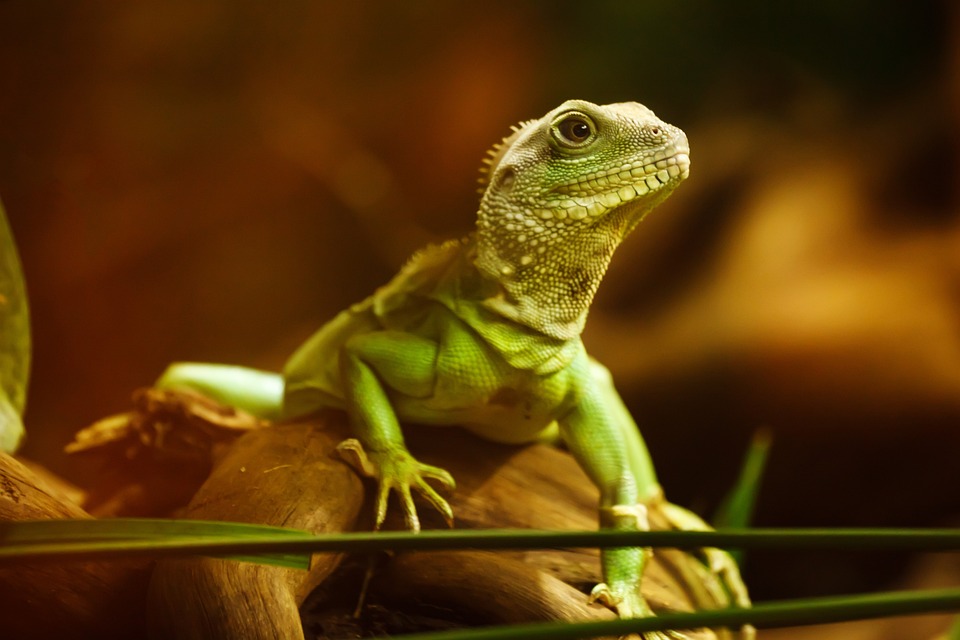
Examples of reptiles are: turtle, cobra, snake, alligator, crocodile, chameleon, iguana and lizard.
Characteristics
Know the main characteristics of the group of reptiles:
Anatomy
The body of reptiles is made up of a head, neck, trunk and tail.
They have locomotive limbs (two pairs), and each of these has five fingers with claws and small legs in some lizards, but absent in others, such as snakes.
They can be crawling or swimming animals. An example is the turtles that have
The skin is dry and resistant, covered by scales of epidermal origin, which makes it keratinized and almost waterproof.
However, some animals, such as turtles, may also have bone plates of dermal origin.
Body temperature
Reptiles are poikilothermic animals, that is, they are unable to maintain a constant body temperature. Thus, they need heat from the environment to regulate body temperature.
This condition limits their location to their habitats in the tropics and subtropics of the planet, where temperatures favor their metabolism. Therefore, reptiles are not found in Antarctica.
Reproduction
Most reptiles are oviparous. Only some snakes and lizards are ovoviviparous.
They present internal fertilization, where the male introduces the sperm inside the female’s body. The development of the embryo takes place inside the eggs, which are covered by horny or calcareous shells.
This characteristic protects the embryo from desiccation, important for conquering terrestrial environments. The egg has the following embryonic annexes: amnion, chorion, yolk sac and allantois.
When the young are born they resemble adults, since development is direct.
Digestive system and feeding
The digestive system is complete. Reptiles have a mouth, pharynx, esophagus, stomach, intestine and anus. Additionally, they have a liver and pancreas.
Most reptiles are carnivorous. A few species are herbivorous and omnivorous.
Some reptiles, such as the alligator and crocodile, are predatory animals and occupy the top of the food chain.
Circulatory system
The circulation is closed, double and complete.
The heart of snakes and turtles has two atria and an incompletely separated ventricle. While crocodiles have two well-defined atria and two ventricles.
Respiratory system
Reptiles have lung respiration. The lungs have pulmonary alveoli, making gas exchanges efficient.
sensory system
The olfactory organ of reptiles allows them to feel taste and smell, since most reptiles can hear sounds.
Vision is not good, but the eyes have a nictitating membrane and eyelids to protect them when submerged.
When they are on land, they are hydrated through tear glands, which is where the expression “crocodile tears” comes from, since these animals “cry” frequently.
Snakes have a loreal pit, a hole between the eye and nose with a thermoreceptor function.
Groups
There are more than 7000 known species and subdivided into four orders:
Order Crocodilia
Crocodiles represent the majority of reptiles that currently exist.
The main characteristics of crocodiles are:
- Body covered by horny plates.
- Presence of four short legs and a tail.
- Large and sharp teeth.
- Heart with four completely separate chambers.
Order Rhynchocephalia
The order Rhynchocephalia is the most primitive group of reptiles. Therefore, tuatara are the only living representatives of this order. They are found in New Zealand and can live in cold environments.
They are carnivorous animals, their teeth fuse with the jaw. Tuatara individuals can reach up to 100 years of age.
Order Squamata
Also known as scaly, as they have a body covered by scales. These are represented by lizards and snakes.
The main characteristics of the Squamata order are:
- They are classified into Lacertílios (lizards) and Ofidios (snakes).
- Lizards have four legs and snakes are apodes, that is, without limbs.
- Some species of snake are poisonous animals.
Testudinata Order
Also called chelonians, they are represented by aquatic (or sea) turtles, tadpoles and jabutis. Aquatic or sea turtles live in a fresh and salt water environment. Tadpoles are found in fresh water and land turtles are found on land.
The main characteristics of chelonians are:
- Presence of bone armor (carapace), which provides protection to the body against mechanical blows and attacks from predators.
- Absence of teeth and presence of a beak with horny plates, allowing food to be captured and cut.
Curiosities
- Dinosaurs, belonging to the super order Dinosauria, belonged to the class of reptiles.
- Brazil is the fourth country in the world with the highest number of reptile species.
- The branch of biology that studies reptiles is called Herpetology.